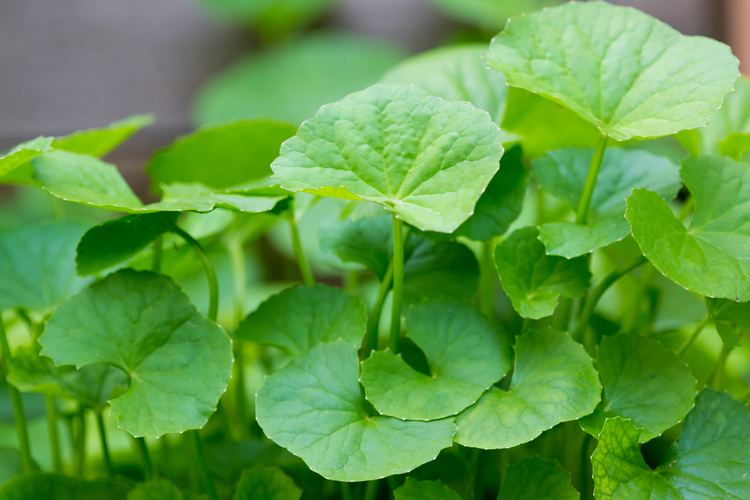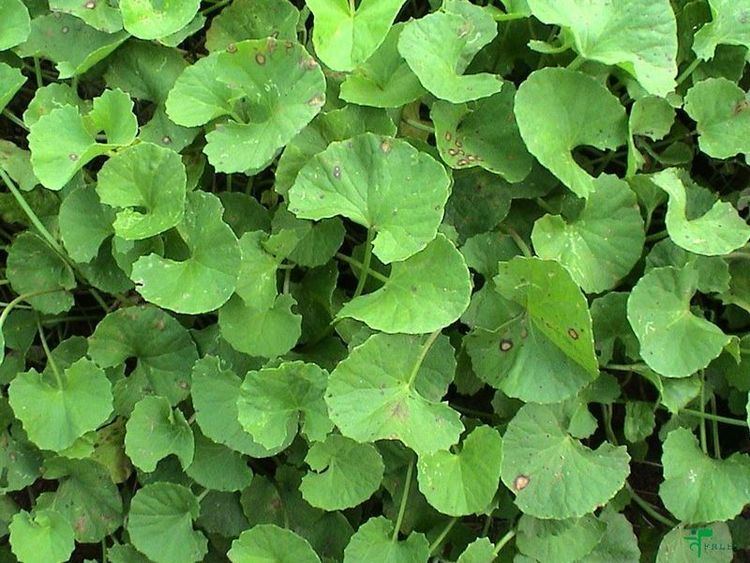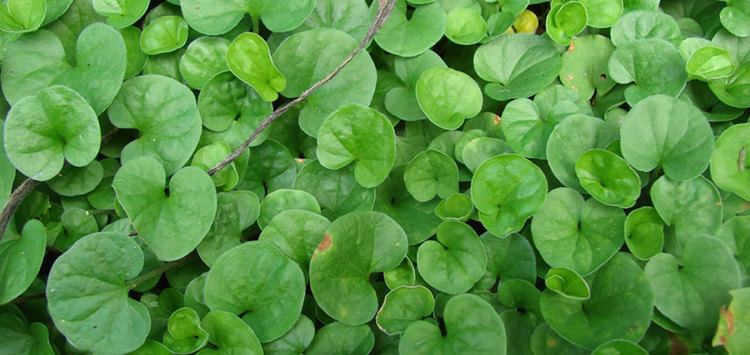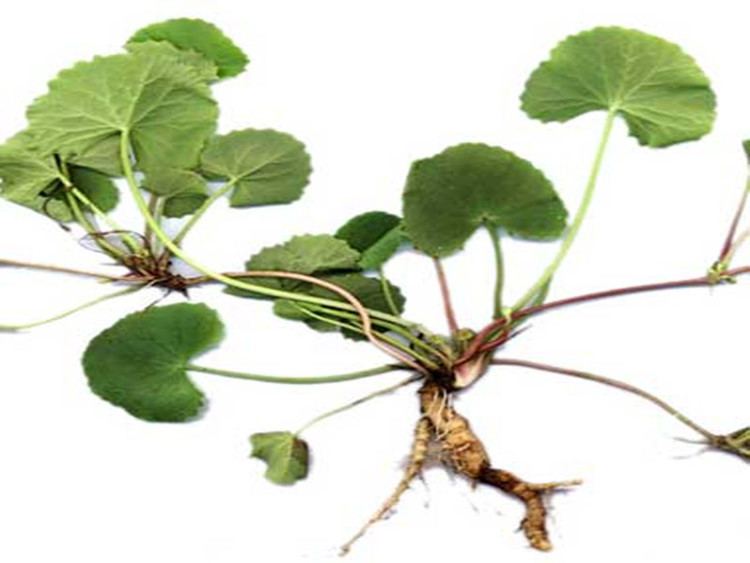Rank Species | Subfamily Mackinlayoideae Scientific name Centella asiatica Higher classification Centella | |
 | ||
Conservation status Least Concern (Population stable) Similar Waterhyssop, Rennet, Maidenhair tree, Green chiretta, European horse‑chestnut | ||
Centella asiatica
Centella asiatica, commonly known as centella, is a small, herbaceous, frost-tender perennial plant of the family Mackinlayaceae or subfamily Mackinlayoideae of family Apiaceae, and is native to wetlands in Asia. It is used as a medicinal herb in Ayurvedic medicine, Western Herbal Medicine, traditional African medicine, traditional Chinese medicine and in western orthodox medicine, for example to stimulate the regeneration of skin in burns while preventing the formation of scar tissue. It is also known as the Asiatic pennywort or Indian pennywort in English, among various other names in other languages.
Contents
- Centella asiatica
- Description
- Habitat
- Culinary use
- Traditional medicine
- Potential as phytoremediation tool
- Chemistry
- Other names
- Folklore
- References

Description

Centella grows in tropical swampy areas. The stems are slender, creeping stolons, green to reddish-green in color, connecting plants to each other. It has long-stalked, green, rounded apices which have smooth texture with palmately netted veins. The leaves are borne on pericladial petioles, around 2 cm (0.79 in). The rootstock consists of rhizomes, growing vertically down. They are creamish in color and covered with root hairs.

The flowers are white or pinkish to red in color, born in small, rounded bunches (umbels) near the surface of the soil. Each flower is partly enclosed in two green bracts. The hermaphrodite flowers are minute in size, less than 3 mm (0.12 in), with five to six corolla lobes per flower. Each flower bears five stamens and two styles. The fruit are densely reticulate, distinguishing it from species of Hydrocotyle which have smooth, ribbed or warty fruit. The crop matures in three months, and the whole plant, including the roots, is harvested manually.
Habitat

Centella asiatica is indigenous to the Indian subcontinent, Southeast Asia, and wetland regions of the Southeastern US. Because the plant is aquatic, it is especially sensitive to biological and chemical pollutants in the water, which may be absorbed into the plant. It can be cultivated in drier soils as long as they are watered regularly enough (such as in a home garden arrangement).
Culinary use

In Myanmar cuisine, raw pennywort is used as the main constituent in a salad made also with onions, crushed peanuts, bean powder and seasoned with lime juice and fish sauce.
Centella is used as a leafy green in Sri Lankan cuisine, being the most predominant of all locally available leafy greens, where it is called gotu kola (ගොටු කොළ). The adjective gotu in Sinhalese, is translated as "an inverted conical shape" (like the shape of a colander) and kola as "leaf". It is most often prepared as malluma (මැල්ලුම), a traditional accompaniment to rice and curry, and goes especially well with vegetarian dishes, such as dhal, and jackfruit or pumpkin curry. It is considered quite nutritious and is often the very first leafy green a weaning toddler is introduced to. In addition to finely chopped gotu kola plants, the gotu kola malluma almost always contains grated coconut, diced shallots, lime (or lemon) juice, and sea salt, and may also contain finely chopped green chilis, chili powder, turmeric powder, chopped carrots as additional ingredients. The Centella fruit-bearing structures are discarded from the gotu kola malluma due to their intense bitter taste. A variation of the nutritious porridge known as kola kenda is also made with gotu kola by the Sinhalese people of Sri Lanka. Gotu kola kenda is made with well-boiled red rice with some extra liquid, coconut milk first extract, and gotu kola purée. The porridge is accompanied with jaggery for sweetness. Centella leaves are also used in modern sweet "pennywort" drinks and herbal teas. In addition the leaves are served stir-fried whole in coconut oil, or cooked in coconut milk with garlic or dhal.
In Indonesia, the leaves are used for sambai oi peuga-ga, an Aceh type of salad, and is also mixed into asinan in Bogor.
In Vietnam and Thailand, this leaf is used for preparing a drink or can be eaten in raw form in salads or cold rolls. In Bangkok, vendors in the famous Chatuchak Weekend Market sell it alongside coconut, roselle, chrysanthemum, orange and other health drinks.
In Malay cuisine the leaves of this plant are used for ulam, a type of Malay salad.
It is one of the constituents of the Indian summer drink thandaayyee.
In Bangladeshi cuisine mashed centella is eaten with rice.
Centella is widely used in various Indian Regional cuisines. It is known as vallarai in Tamil. It is an important component of unave marunthu concept which translates to food is medicine. Vallarai Kootu is a dish made out of centella and Dal. Vallarai thuvaiyal/thugaiyal, poriyal, spice podi (to be mixed with rice and ghee) and chutney are all various applications of centella in home cooking.
Traditional medicine
In traditional herbal medicine, C. asiatica has been used in an attempt to treat varicose veins, chronic venous insufficiency, psoriasis, minor wounds, strangury, and to encourage lactation. According to the American Cancer Society, "Although at least one laboratory study of tumor cells showed reduced cell growth with gotu kola, available scientific evidence does not support claims of its effectiveness for treating cancer or any other disease in humans".
Potential as phytoremediation tool
In the context of phytoremediation, C. asiatica is a potential phytoextraction tool owing to its ability to take up and translocate metals from root to shoot when grown in heavy-metal-contaminated soil.
Chemistry
Centella has large amounts of pentacyclic triterpenoids including asiaticoside, brahmoside, asiatic acid, and brahmic acid (madecassic acid). Other constituents include centellose, centelloside, and madecassoside.
Other names
In South Asia, other common names of centella include ଥାଲକୂଡ଼ି (Thalkudi) in Odia; సరస్వతి ఆకు (sarswathi aku) in Telugu; കുടവൻ (kudavan), മുത്തിൾ (muththil), or കുടങ്ങൽ (kudangal) in Malayalam; থানকুনি (thankuni) in Bengali; ගොටුකොල (gotu kola) or සරස්වතී (sarasvatī - which means Goddess of knowledge, music, arts, wisdom and learning) in Sinhala; ब्राम्ही / ब्राह्मी (brahmi) in Marathi; एक्पानि("ekpaani") meaning "one leaf" in Konkani; ಒಂದೆಲಗ (ondelaga) in Kannada; வல்லாரை (vallaarai) in Tamil; ျမင္းခြာ (myin-khwar) in Burmese; brahmi booti in Hindi; perook in Meitei; lambak in Mizo; মানিমুনি (manimuni) in Assamese; timare in Tulu; tangkuanteh in Paite; ब्रह्मबुटि (brahmabuti) or घोडताप्रे (ghod-tapre) in Nepali; and खोलचा घायँ (kholcha ghyan) in Newari (Nepal Bhasa), and Kuakclei in Rongmei, Kongreihan in Tangkhul language, Raivuh in Poumai language, Ashebaghiye in Sumi language.
In India, particularly, it is popularly known by a variety of names: bemgsag, brahma manduki, brahmanduki, brahmi, ondelaga or ekpanni (south India, west India), sarswathi aku (Andhra Pradesh), gotu kola, khulakhudi, mandukparni, mandookaparni, or thankuni (Bengal), depending on region. Bacopa monnieri is the more widely known Brahmi; both have some common therapeutic properties in Vedic texts and are used for improving memory. C. asiatica is called brahmi particularly in north India, although that may be a case of mistaken identity introduced during the 16th century, when brahmi was confused with mandukaparni, a name for C. asiatica. Probably the earliest study of mandookaparni as medya rasayana (improving the mental ability) was carried out at the Dr. A. Lakshmipathy Research Centre (now under CCRAS).
In Southeast Asia, it is known as ស្លឹកត្រចៀកក្រាញ់ (sleuk tracheakkranh) in Khmer; မြင်းခွာပင်(မြင်းခွာရွက်) (mying khwar which means "Horse Hoof leaf" ) in Burmese; บัวบก (bua bok; "land lily") in Thai; rau má in Vietnamese; pegagan or antanan in Indonesian; takip-kohol (literally "snail lid") or yahong yahong ("little bowl") in Filipino; and penggaga, pegagan or pegaga in Malay.
In East Asia, it is known as 雷公根 (lei gong gen; literally "thunder god's root") or 崩大碗 (bang dai wun; literally "chipped big bowl") in Chinese; and 병풀 (byeong-pul, 甁—, literally "bottle/jar grass") in Korean.
Folklore
Gotu kola is a minor feature in the longevity tradition of the T'ai chi ch'uan master Li Ching-Yuen. He purportedly lived to be 197 or 256, partly because of his usage of traditional Chinese herbs, including gotu kola.
